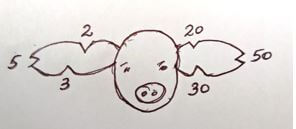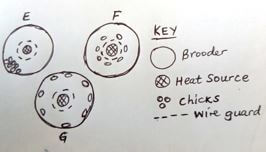INSTRUCTIONS TO CANDIDATES:
- This paper consists of three sections A, B and C.
- Answer all the questions in section A and B.
- Answer any two questions in section C.

QUESTIONS
SECTION A: (30 MARKS)
- Name two exotic breeds of dairy goats. (1 mk)
- State four advantages of natural method of rearing calves. (2 mks)
-
- Name livestock commonly attacked by keds. (½ mk)
- Give three signs of attack by keds on livestock named in 3(a) above. (1½ mk
- State four disadvantages of a hedge in a farm. (2 mks)
-
- Name a tool used in carrying out each of the following practices:
- Cutting galvanized iron sheet - (½ mk)
- Cutting wood along the grains - (½ mk)
- Marking lines parallel to the edge of stock - (½ mk)
- Placing mortar between construction stones - (½ mk)
- Name a tool used in carrying out each of the following practices:
- State four maintenance practices carried out on a jack plane. (2 mks)
- State four signs of parturition in a cow. (2 mks)
- Explain how the following methods help in controlling livestock diseases:
- Mass slaughter ½ mk)
- Proper feeding - ½ mk)
- Quarantine - ½ mk)
- Vaccination - ½ mk)
- Give two uses of litter in a brooder. (1 mk)
- State two reasons for dehorning in cattle. (2 mks)
- Give four essentials of clean milk production in a herd. (2 mks)
- Give four predisposing factor of pneumonia in cattle. (2 mks)
- State four factors that determine digestibility of a feed. (2 mks)
- Give four methods of preserving fish. (2 mks)
- Give four disadvantages of using thatch in construction of farm buildings. (2 mks)
- State four reasons for swarming in bees. (2 mks)
SECTION B: (20 MARKS) -
- A farmer was advised to prepare 180kg of calf ration containing 20% DCP. Using pearsons square method, calculate the amount of maize containing 10% DCP and sunflower containing 40% DCP the farmer needs to use. Show your working. (4 mks)
- State two factors considered when formulating a livestock ration. (2 mks)
- Study the diagram below and answer the questions that follow.

- Name the type of identification illustrated above. (1 mk)
- Give the identification number of the pig illustrated above. (1 mk)
- Using a diagram, illustrate how animal number 83 can be identified using the above method. (2 mks)
- What is the use of metal rails in a farrowing pen. (1 mk)
- The diagrams below shows the behaviour of chicks in a brooder in response to heat.

- Explain the behaviour of chicks in brooder;
E – (1 mk)
F – (1 mk)
G – (1 mk) - Explain why the brooder is rounded. (1 mk)
- Explain the behaviour of chicks in brooder;
- The diagram below shows the structure of the udder of a cow. Study it then answer the questions that follow.

- Identify parts labeled K and L. (2 mks)
K –
L – - Name two hormones that control milk let-down in a dairy cow. (2 mks)
- Name one disease that attacks part labeled L. (1 mk)
SECTION C: (40 MARKS)
- Identify parts labeled K and L. (2 mks)
-
- Describe the physical characteristics of a good dairy cow for breeding. (10 mks)
- State five functions of water in the body of livestock. (5 mks)
- Explain the advantages of a four stroke cycle engine. (5 mks)
-
- Explain five factors that affect milk composition in dairy cattle. (5 mks)
- Describe five factors that may lead to failure of a cow to conceive after service. (5 mks)
- Explain the factors that a farmer should consider when selecting materials to construct a zero grazing unit. (10 mks)
-
- Describe milk fever under the following sub-headings:
- Animal affected. (1 mk)
- Cause of disease. (1 mk)
- Symptoms. (5 mks)
- Control measures. (3 mks)
- Outline the advantages of artificial insemination in cattle. (10 mks)
- Describe milk fever under the following sub-headings:

MARKING SCHEME
- Exotic breeds of dairy goats
- Toggenburg
- Jamnapari
- Saanen
- Anglo Nubian
- Advantages of natural method of rearing calves
- Calf takes milk at body temp
- Milk is free from contamination
- Problems of scouring are minimized
- Calf gets adequate milk for its nutritional requirements
-
- Sheep
-
- Cause irritation under heavy infestation
- Damage wool due to scratching
- Results in retarded growth in lambs
- Animals becomes anaemic
-
- Not suitable for paddocking as they occupy a lot of space
- Act as hiding place for vermins and thieves
- Thorny species can injure livestock and human beings
- Take long to establish
- Require regular trimming and gapping hence expensive
- Show irregular growth leaving gaps
-
- Tinsnip
- Rip saw
- Mortise gauge
- Mason’s trowel
-
- Cleaning after use
- Lubricating the adjustable screw
- Replace broken parts
- Tightening loose nuts and screws
- Replace broken parts
- Sharpening plane iron
-
- Restlessness
- Enlargement or swollen vulva
- Clear mucus discharge from vulva.
- Slackening of pelvic muscles
- Full and distended udder
- Thick milk from teats
- Water bag appear just before birth.
-
- Mass slaughter: killing all infected animals to prevent spread of disease.
- Proper feeding: makes animal resistant to diseases controls nutritional diseases
- Quarantine: Prevents introduction or spread of disease from one area to another.
- Vaccination – Prevents infection of the disease
-
- Absorbs moisture
- Keeps the brooder warm
- Keeps birds busy/scratching
-
- Prevents injury to other animals and human beings
- Prevents destruction of farm structures
- Make the animal beautiful
- To calm the animal
- Enhances economic use of space
- Improves growth rate
-
- Clean cows
- Clean milking shed
- Healthy milking herd
- Clean milking utensils
- Healthy and clean milkman
- Milk filtration, cooling and storage
-
- Poor ventilation of livestock houses
- Age of the animal
- Dampness and chilliness in livestock houses
- Overcrowding
- Effects of diarrhea and other illness
-
- Animal species
- Chemical composition of the feed
- Form in which the food is given to the animal
- Quantity of food present in the digestive system
- Energy to protein ratio in the feed.
-
- Freezing
- Smoking
- Salting
- Sun drying
-
- Harbours vermin
- Catch fire easily
- Require regular maintenance
- Can leak if not well placed
-
- Shortage of food and water in their surrounding
- Outbreak of diseases and parasites
- Damage to brood combs
- Lack of adequate ventilation
- Dampness and bad smells
- Sick or infertile queen
- Overcrowding
-
- Maize = 20 x 180 = 120kg
30
Sunflower = 10 x 1180 = 60kg
30 -
- Age of the animal
- Cost of feedstuff
- Type of animal whether ruminant or non-ruminant
- Nutrient requirement of the animal
- Availability of feedstuff
- Maize = 20 x 180 = 120kg
-
- Ear notching
- 5 + 3 + 2 + 50 + 30 + 20 = 110 (must show the working)
- (Any other combination unacceptable)
- Prevents sow from crushing the piglets
-
- E – There is draught from the side directly opposite where the chicks have crowded.
F – Its very cold in the brooder chicks crowd around heat source
G – Too much heat making chicks move far away from heat source - To avoid overcrowding at one point which may lead to suffocation.
- E – There is draught from the side directly opposite where the chicks have crowded.
-
- K – alveoli L – gland cistern
- Oxytocin Adrenalin
-
-
- Wedge/Triangular shaped.
- Big stomach to store more food
- Large well developed udder and teats
- Well set hind quarters to allow room for big udder
- Long thin neck and small head
- Lean body with little flash
- Large milk veins and milk wells
- Straight top line
- Long thin legs
- Prominent pin bones
-
- Regulates body temp
- Transportation of nutrients
- Component of body cells and fluids
- Make cells turgid
- Used in biochemical reactions
- Helps in excretion of waste products
- Forms part of animal products.
-
- Produce high power
- Have efficient fuel and oil utilisation
- Performs wide range of farm operations
- Engines are efficiently cooled with water
- Exhaust gases are effectively expelled
- Regulates body temp
-
-
-
- Age of the animal: old animals produce milk with low butter fat content
- Stage of lactation: butter fat content is high in the middle phase of lactation
- Completeness of milking: Last drawn milk from udder has higher butter fat content.
- Season of the year: butter fat content increases during cold season.
- Type of food eaten: food rich in roughages is richer in butter fat content.
- Animals health: mastitis reduce butter fat content leading to watery milk
- Breed – Jersey produce milk with more butter fat content
- Physiological condition: Last stage of pregnancy has milk with lower butter content
- Nutrition: Mexican marigold and silage taints milk if fed before milking.
-
- Wrong timing of service
- Low quality/expired semen
- Poor skilled veterinary officer
- Infertile cow
- Blocked fallopian tubes/oviduct
- Hormonal imbalance
- Disease infection e.g. brucellosis
-
- Cost of the material
- Durability
- Workability
- Toxicity of materials to workers/animal
- Farmers taste and preferences
- Type of zero-grazing unit
- Availability of skilled labour
- Capital available
- Suitability
- Environmental conditions
-
-
-
- Cows/Nannies/sows that have recently given birth
- Low calcium levels in blood leading to increase in magnesium and sugar levels.
-
- Muscular twitching causing animals to tremble
- Staggering as the animal moves
- Animal lies down on its side and whole body stiffens/neck twisted
- Body functions eg urination stops
- Stomach contents drawn to the mouth
- Complete loss of appetite/anorexia
- Dullness
- Animal falls down and becomes unconscious
- Control
- Partial milking for first 10 days
- Intravenous injection with calcium salts
- Feed the animal with diet rich in calcium and phosphorus
- Giving high doses of vitamin D
- AI
- Semen of a bull can be used even after its death
- Heavy bulls can produce semen to serve
- Controls breeding diseases
- Prevents inbreeding
- Eliminates dangerous bulls in the farm
- Useful as a research tool
- Easier and cheaper to transport semen that a bull
- Quicker method to obtain a proven sire
- Semen from one superior bull can serve many cows
- Saves costs of rearing a bull
- Controls breeding
-
Join our whatsapp group for latest updates
Tap Here to Download for 50/-
Get on WhatsApp for 50/-
Download Agriculture Paper 2 Questions and Answers - Form 4 Term 2 Opener Exams 2022.
Tap Here to Download for 50/-
Get on WhatsApp for 50/-
Why download?
- ✔ To read offline at any time.
- ✔ To Print at your convenience
- ✔ Share Easily with Friends / Students

